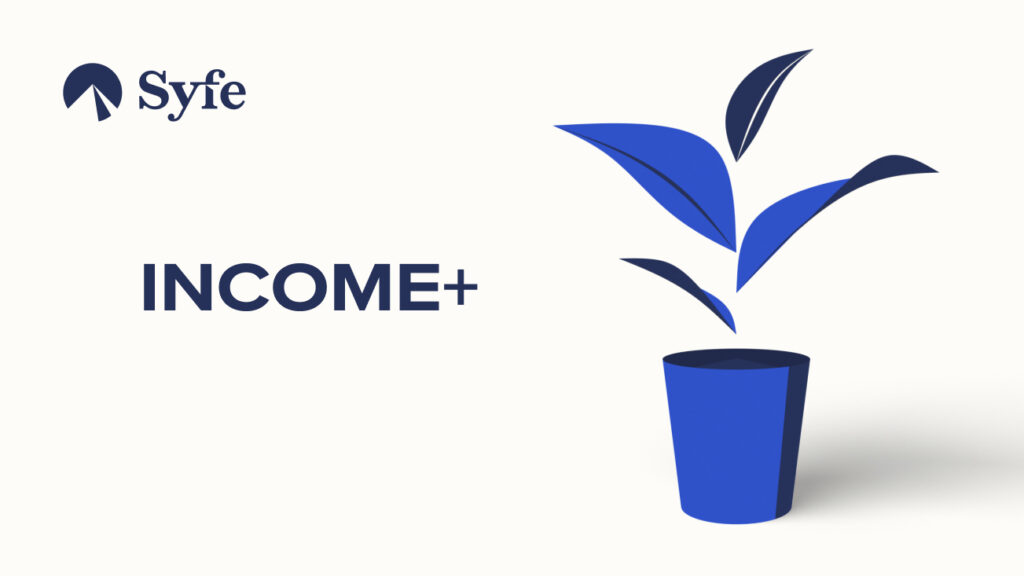
Introducing Syfe Income+, Powered by PIMCO
We are very excited to launch Syfe’s Income+ portfolios in partnership with PIMCO, a global leader in active fixed income.
The current geopolitical and economic uncertainties, unprecedented inflation and high rates environment have created favourable conditions for fixed income investing. Bond markets are offering the highest yields and total return potential in years and therefore can offer better value than past decades.
Syfe Income+ is a one of a kind offering where we bring to you PIMCO’s best-in-class fixed income strategies. We have built it using a unique portfolio construction process that is informed by PIMCO’s forward looking views and time tested investment approach with an aim to deliver the best outcome for all your income needs.
In this article:
- Investment Process
- Portfolio Information & Optimisation
- Institutional Fund Access, At a Fraction of the Cost
- Payouts to Your Bank Account
Investment Process
Syfe Income+ portfolios are discretionary in nature and we have built them in partnership with PIMCO, whose role is to provide insights and non-binding asset allocation guidance to Syfe in the portfolio construction process. Syfe manages and provides these portfolios to you and we take care of all your servicing and advisory needs.
Informed by PIMCO’s model portfolio investment approach, Syfe has constructed the Income+ portfolios based on a multi-step process, which includes defining the investment opportunity set and model guardrails and optimising allocations based on key macro themes, opportunities and risks.
Income+ With Monthly Payouts of 5.0-6.0% p.a.*
We have created two variations of Syfe’s Income+ offering to cater to the different income needs of our investors.
- Income+ Preserve is built for investors looking to generate a steady regular income while seeking to preserve capital.
- Income+ Enhance is built for investors seeking to generate higher current income and long term capital appreciation.
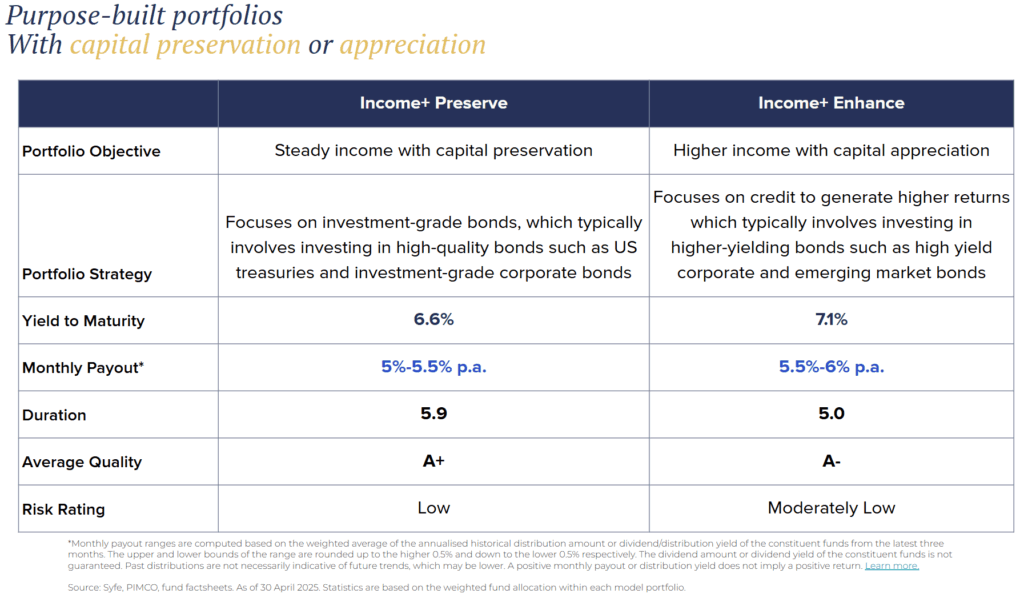
Portfolio optimisation recommendations based on forward looking views
Income+ portfolios come with a special optimisation feature that allow clients to adjust their portfolio allocations with ongoing recommendations from Syfe.
These recommendations will be informed by PIMCO’s forward looking views on the market based on credit spreads, yields, and economics forums to identify the most attractive investments.
Syfe will make these recommendations to clients on a semi-annual basis. Clients will have the choice to either accept the recommendation or not. Clients who accept the recommendations will have their portfolio allocations adjusted to the latest target asset allocation guidance by Syfe. Clients who do not accept the recommendations will continue with their current allocations. We encourage clients to follow the recommendations to adapt their portfolios to changing market conditions and keep their portfolio returns optimised.
Automatic rebalancing to address price drifts
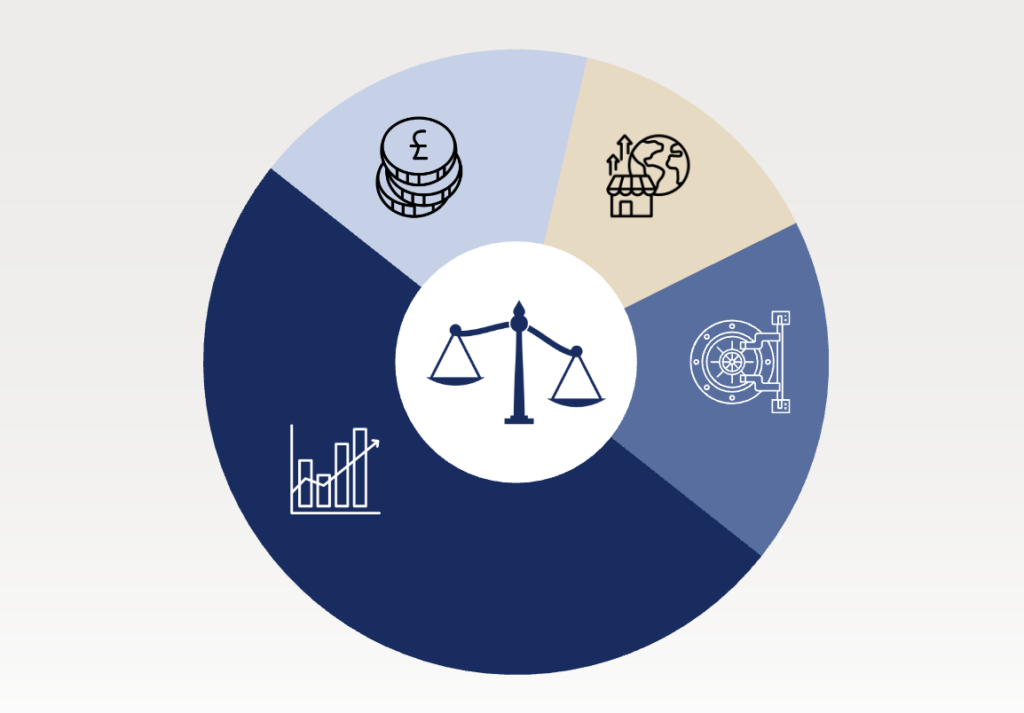
Syfe may automatically rebalance the portfolios on a periodic basis if the portfolios are out of alignment with their respective target asset allocation due to price drifts. This helps clients to stay aligned to the target asset allocation of their portfolios. Investing in the Income+ portfolios automatically opts you into this feature.
Using PIMCO’s best-in-class active funds to deliver optimal returns for your income needs
Income+ portfolios use PIMCO’s best-in-class active funds as building blocks. While we continue to advocate passive strategies built using ETFs for most of our growth oriented portfolios, we believe active funds are better suited to solve the core income needs of clients. Active funds have the following advantages compared to ETFs when investing for income, making them our vehicle of choice for our Income+ portfolios.
- Active management: Income+ uses PIMCO funds that are actively managed and are able to utilise a broad range of fixed income securities that seek to produce an attractive level of income while maintaining a relatively low risk profile. Most ETFs, on the other hand, are managed passively and are limited in their ability to cater to the specific income needs of investors as well as adapt to different market situations.
- Tax efficient: Given dividends form the major chunk of returns for income investors, any tax implications on it may have a significant impact on the overall returns. The funds used in the Income+ portfolios are domiciled in Ireland making them more efficient with respect to dividend withholding taxes. Compared to US domiciled ETFs, using Irish-domiciled funds can help Singapore-based investors save as much as 30% of dividend withholding taxes.
- SGD-hedged: Income+ portfolios invest into SGD-hedged share classes of the constituent funds to mitigate currency risks. This is especially important for investors looking for a stable monthly dividend profile. Unhedged USD denominated ETFs may result in volatile SGD dividend payouts and cause disruptions in the ongoing income needs of clients.
Portfolio Composition
Income+ Preserve employs a strategy that focuses on investment grade quality bonds which typically involves investing in high-quality bonds such as US Treasuries and investment-grade corporate bonds.

Income+ Enhance employs a strategy that focuses on credit to generate higher returns which typically involves investing in higher-yielding, lower-rated bonds such as high-yield corporate bonds and emerging market bonds.

Institutional Fund Access, At a Fraction of the Cost
We endeavour to bring to our clients the best-in-class institutional strategies at a fraction of the cost that is typically applicable to access them. Even in cases where we need to use retail/admin share class funds (mainly when they pay monthly dividends), Syfe passes on to the investors any trailer fee rebates it receives from the fund manager, resulting in significant cost savings.
The below tables illustrate how clients may save as much as 60% of fund level fees when investing through Income+ portfolios compared to DIY as a retail investor.

Source: Syfe, fund factsheets. As of 31st July 2023. Statistics are based on the weighted fund allocation within each model portfolio.
Monthly Payouts Directly to Your Bank Account
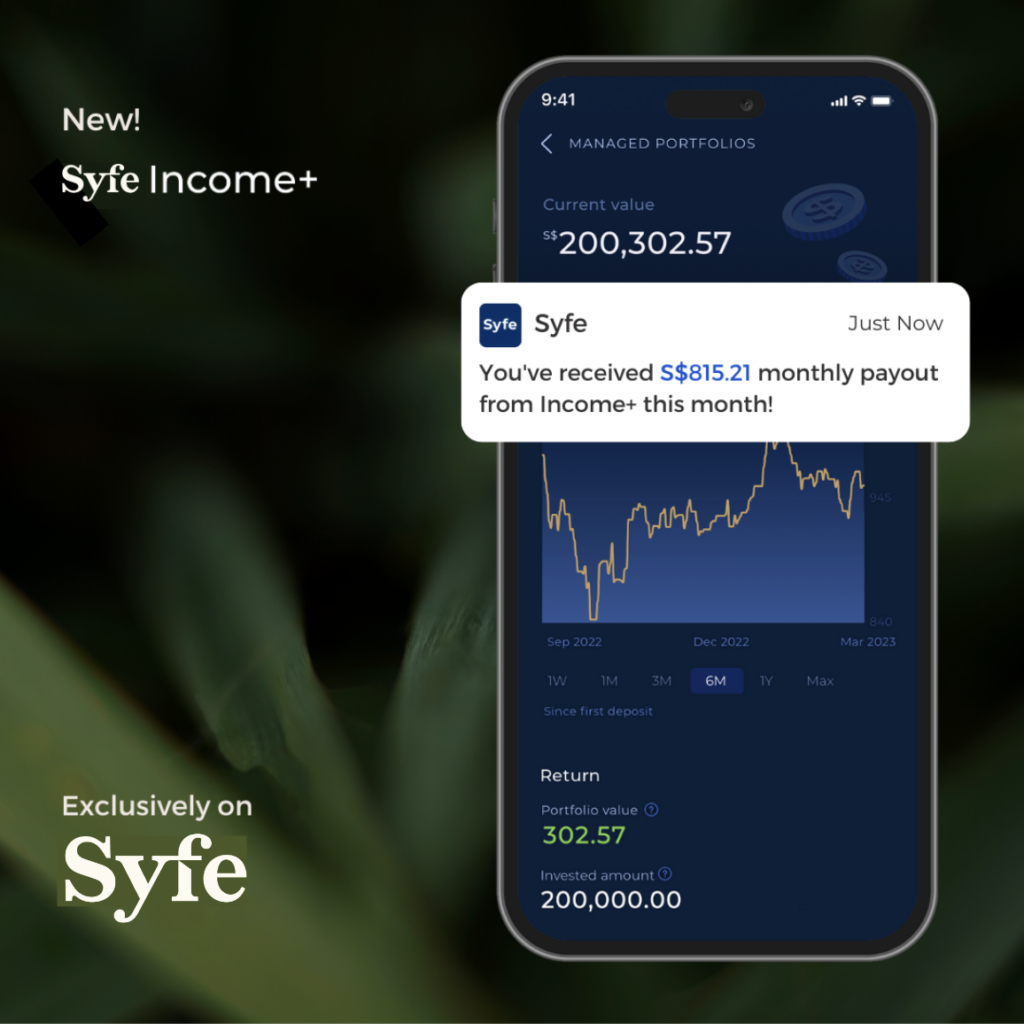
Both of the Income+ options aim to pay monthly dividend distributions directly to your bank account. The monthly payout ranges for the two portfolios are computed by Syfe based on the historical distribution yields of the constituent funds. Please refer to the definitions section for methodology.
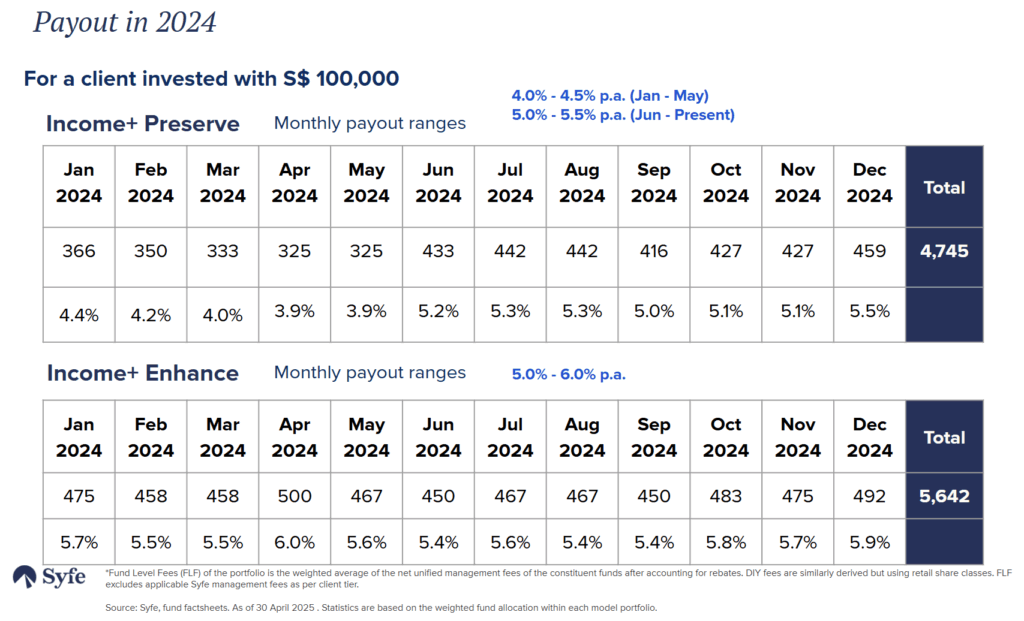
The Income+ portfolio has a minimum funding threshold of S$5,000, and clients have an option to switch between receiving a monthly payout or channelling payouts into auto dividend reinvestments depending on their immediate income needs. For those on payout, the portfolios will accumulate the dividends from the constituent funds on a monthly basis and payout the proceeds to your bank account within the first 10 days of the following month.
Summary
In building these Income+ portfolios, Syfe hopes to address the core needs of investors in providing a regular stream of passive income that can tide you through the years as you invest for your financial goal. Global income plays an important role in any investors’ portfolios, but especially in todays’ context of rising rates and uncertain market conditions.
As with all Syfe portfolios, Income+ offers no lock-ins, free unlimited portfolio transfers and zero withdrawal fees to provide you with the flexibility and agility you need as you build wealth for the long-term. Keen to start investing in Income+ today? Find out more here.
Investing in Syfe’s Income+ portfolios takes less than 10 minutes. If you’re new to Syfe, create your account in three minutes using Singpass. Thereafter, you can use PayNow or Internet banking to make your first transfer to your preferred Income+ portfolio. If you’re an existing Syfe customer, simply click on ‘Add New’ to add the Income+ portfolio to your investments.
More articles on Income+
- Differences Between Syfe Income+ vs T-Bills, Singapore Savings Bonds and Fixed Deposits
- Constructing a Bond Portfolio with ETFs vs Unit Trusts
This article is for informational purposes only and should not be viewed as financial advice. It is not meant to market any specific investment, or offer or recommend the purchase or sale of any specific security. All forms of investments carry risks, including the risk of losing all of the invested amount. Such activities may not be suitable for everyone. This advertisement has not been reviewed by the Monetary Authority of Singapore.
Definitions
Objective
Investors should consider the investment objectives, risks, charges and expenses of the constituent funds carefully before investing. This and other information is contained in the constituent funds’ prospectus. Please read the constituent funds’ prospectus carefully before you invest or send money. Past performance is not a guarantee or a reliable indicator of future results and no guarantee is being made that similar returns will be achieved in the future.
Monthly Payout
Monthly payout ranges are computed based on the weighted average of the annualised historical distribution amount or dividend/distribution yield of the constituent funds. The upper and lower bounds of the range are rounded up to the higher 0.5% and down to the lower 0.5% respectively. For example, 4.2% is rounded down to 4.0% while 5.6% is rounded up to 6.0%. Dividends for the constituent funds are declared either on a monthly or quarterly basis. For funds with monthly distribution, the annualized distribution yields are annualised on a 12 month calendar year [Annualised distribution yield= (Dividend Rate * 12) / NAV on ex-dividend day]. For funds with quarterly distribution, the annualised distribution yields are annualised on a 12 month calendar year [Annualised distribution yield= (Dividend Rate * 4) / NAV on ex-dividend day]. The dividend amount or dividend rate/yield of the constituent funds is not guaranteed. The dividend amount or dividend distribution rate/yield is based on historical dividend amount or dividend rate/yield from Dec 2022 to Feb 2023. Past distributions are not necessarily indicative of future trends, which may be lower. A positive monthly payout or distribution yield does not imply a positive return. Distribution payments of the constituent funds where applicable, may at the sole discretion of the constituent funds, be made out of either income and/ or capital of the constituent funds. The constituent funds may at its discretion pay dividends out of capital and charge management and other fees payable by the constituent funds to capital of the constituent funds, thereby resulting in an increase in distributable income available for the payment of dividends by the constituent funds and therefore, the constituent funds may effectively pay dividends out of capital. The constituent funds may also charge other fees to capital and also take into account the yield differential arising from share class currency hedging (which constitutes a distribution from capital). This may result in an immediate reduction of the NAV per share for the constituent funds. Please refer to www.pimco.com.sg for more information on income statistics.
The constituent funds may use or invest in financial derivative instruments and be subject to various risks (including for e.g. liquidity risk, interest rate risk, market risk, credit risk and management risk etc.) associated with such investments in financial derivative instruments. A constituent fund’s use of, or investment in, financial derivative instruments involves risks different from, or possibly greater than, the risks associated with investing directly in securities and other traditional investments. Participation in the markets for financial derivative instruments involves investment risks and transaction costs to which a constituent funds may not be subject if such strategies are not used. Investors should consider the investment objectives, risks, charges and expenses carefully before investing. This and other information is contained in the constituent fund’s Singapore Prospectus which is available and can be obtained from PIMCO website www.pimco.com.sg.
Yield to Maturity (YTM)
Estimated Yield to Maturity (YTM) of a bond is the total return that an investor stands to receive if all scheduled payments are made on time and the bond is held until maturity. Estimated YTM of the portfolio is the weighted average of the YTM of the bonds held in the constituent funds in the portfolio. It does not represent the portfolio’s return. The measure does not reflect the deduction of fees and expenses and is not necessarily indicative of the portfolio’s actual performance. A portfolio’s actual yield or distribution rate may be significantly lower than its estimated YTM in practice. Also, estimated YTM is not intended to indicate that a portfolio will actually hold any or all of its portfolio securities to maturity in practice, and various securities may be sold or otherwise disposed of prior to maturity. Estimated YTM is not a projection or prediction of the actual yield or return that a portfolio may achieve or any other future performance results. There can be no assurance that a portfolio will achieve any particular level of yield or return and actual results may vary significantly from estimated YTM.
Duration
Duration is a measure of the sensitivity of the price of a bond to a change in interest rates. Generally, the higher a bond’s duration, the more its value will fall as interest rates rise, because when rates go up, bond values fall and vice versa. Duration of the portfolio is the weighted average of the duration of the individual bonds held in the constituent funds of the portfolio.
Credit Quality
Credit quality gives a snapshot of the portfolio’s overall credit quality. It is an average of each bond’s credit rating held in the constituent funds, adjusted for its relative weighting in the portfolio.
Beta vs S&P 500
Beta vs S&P 500 measures the volatility of the returns of the portfolio against the broader market (S&P 500). It is a measure of risk and allows investors to gauge how sensitive the portfolio might be to macro market risks. For positive equity beta below 1, a lower equity beta value implies lesser risk as it denotes lesser positive correlation to the broader market while a higher value implies greater risk.
US Gov. Related
May include nominal and inflation-protected Treasuries, Treasury futures and options, agencies, FDIC-guaranteed and government-guaranteed corporate securities, and interest rate swaps.
Securitized
The Securitized bucket will include Agency MBS, non-Agency MBS, CMBS, ABS, CDO, CLO, and Pooled Funds.
Invest. Grade Credit
Consists primarily of creditworthy corporate issuers having a debt rating of BBB-or greater by at least one of the recognized credit rating agencies or, if unrated, determined by PIMCO to be of comparable quality.
High Yield Credit
Are bonds with a credit rating below investment-grade -typically “BB” or lower as rated by S&P or “Ba” or lower by Moody’s. They typically offer a higher yield than investment-grade bonds but have higher risk.
Non-USD Developed
Includes developed market securities denominated in a currency other than the US Dollar.
Emerging Markets
Includes an emerging market security or other instrument economically tied to an emerging market country by country of risk. Short duration emerging markets instruments are emerging markets instruments with an effective duration less than one year and rated investment grade or higher or if unrated, determined to be similar quality by PIMCO. Emerging Markets includes the value of short duration emerging markets instruments.
Syfe Risk Rating
All Syfe portfolios are assigned a product risk rating based on the risk characteristics / drawdown metrics of the portfolio.
- Low risk: Preservation of capital and the generation of regular income slightly above inflation or short-term money market rates.
- Moderately low risk: Investments that typically aim to provide a balance of income and capital appreciation.
Fund Level Fees
Fund Level Fees refer to the unified management fees of the constituent funds which are charged by the fund manager, in this case PIMCO.
Net Fund Level Fees
Net Fund Level Fees of the portfolio is the weighted average of the net unified management fees of the constituent funds after accounting for rebates. For institutional share class funds, the gross and net fund level fees are the same. For retail/admin share classes, the net fund level fees are calculated by subtracting the unified management fees of the constituent funds with applicable trailer fee rebates which Syfe wholly passes on to its clients.
Trailer Fee Rebate
Trailer Fee Rebate is a fee that a fund manager pays intermediaries. The rebate is usually applicable when the fund’s share class is retail. Currently, Syfe passes on to clients any trailer fee rebates it receives for any of the constituent funds of Income+ portfolios.
Syfe’s Income+ portfolios are discretionary portfolios provided by Syfe to you. These portfolios comprise of PIMCO funds and PIMCO provides Syfe with non-binding model portfolio guidance.
This means that PIMCO does not provide any service or product to you and does not receive any information about you. By investing into the Income+ portfolio(s), you are a client of Syfe only.
You may purchase shares of the constituent funds in the Income+ portfolios directly with other financial intermediaries which may result in higher or lower cost to you depending on the share class(es) you are eligible for.
PIMCO is not affiliated with Syfe and has no obligations nor responsibilities regarding the acquisition, disposition or holdings of any portfolios offered by Syfe nor does PIMCO have any obligation or liability to any client of Syfe.
Investment involves risk including possible loss of the principal amount invested. The portfolios and/or the constituent funds in the portfolios may not achieve their investment objectives. Any past performance, projection, forecast or simulation of results is not necessarily indicative of the future or likely performance of any investment. Investors should consider the investment objectives, risks, charges and expenses carefully before investing. This and other information is contained in the constituent funds’ prospectus. Please read the prospectus carefully before you invest or send money.
The information in this website is for information only. The information and opinions contained in this publication has been obtained from sources believed to be reliable at the time of writing, but Syfe makes no representation or warranty as to its adequacy, completeness, accuracy or timeliness for any particular purpose. Opinions and estimates are subject to change without notice. Syfe does not provide legal, tax or accounting advice.
There is no assurance that the credit ratings of any securities mentioned in this publication will remain in effect for any given period of time or that such ratings will not be revised, suspended or withdrawn in the future if, in the relevant credit rating agency’s judgment, the circumstances so warrant. The value of any product and any income accruing to such a product may rise as well as fall.



You must be logged in to post a comment.